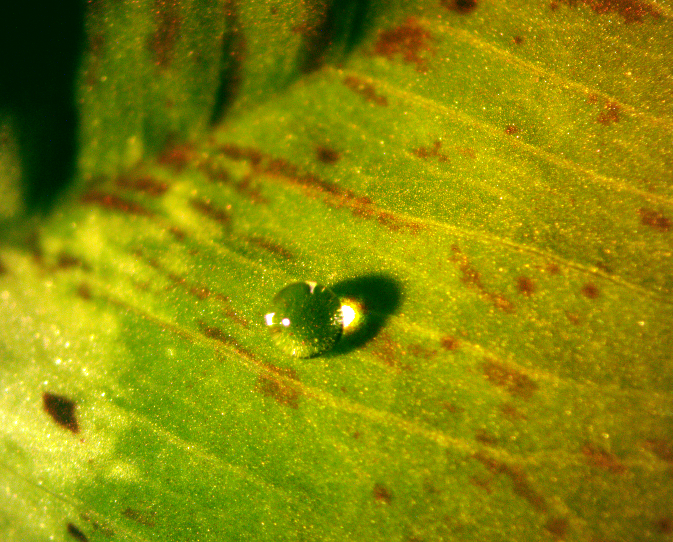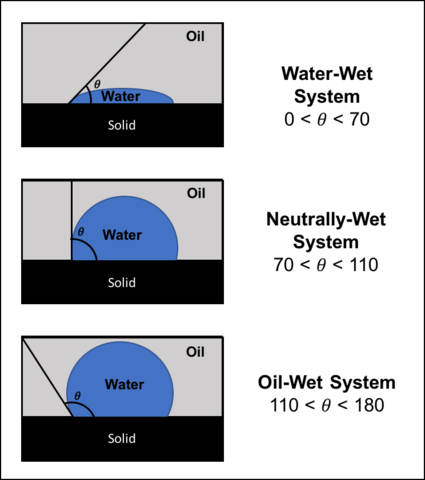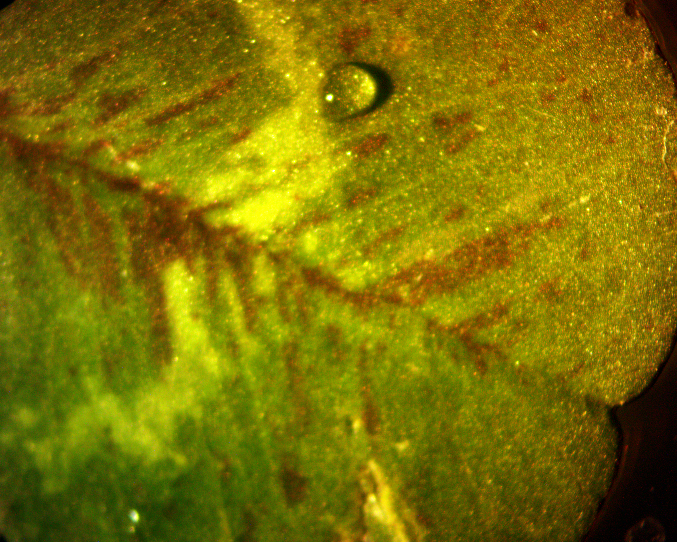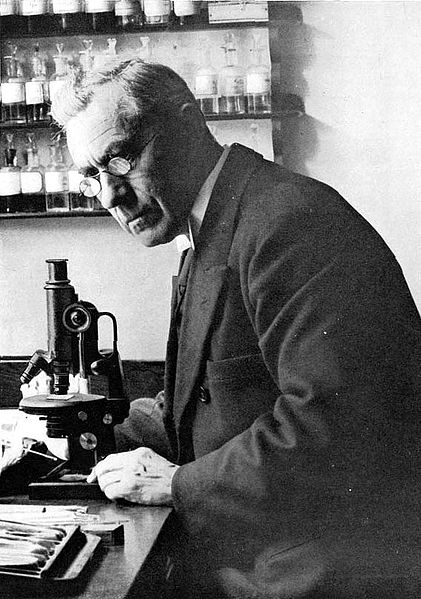*Trifolium* and its billions of helpers: A holiday themed nitrogen festival
This tiny plant has been our helper for millennia and I was inspired today to go out, take a sample, and get a few close-up images on my dissecting scope. Can you guess what this is?

A digression into hydrophobicity
As the title hints at, Trifolium spp. has many tiny and large friends, and they're the ones I want to write about, but I can't just gloss over the gorgeous little water drop. A lot of times when you're exploring the natural world stuff other than what you were looking for crops up and if you keep your eyes open, you can see some wonderful things. The water droplet was a side effect of me washing some dirt off the leaves and hoping to wet them enough to lie flat on a slide. I was unaware that the leaves were so hydrophobic ('water-hating') - as best I can tell this is due to fine hairs on the leaf surface repelling the water. This makes sense as it grows close to the ground and too much water on the leaves would probably lead to fungal issues and other rot.
Apart from the aesthetics, one thing I really like about this water droplet is that it's a great example of how we use something called a contact angle to measure a surface's tendency to repel water (or be wetted by it). Basically, there's a balance of physical forces which determine the contact angle, and thus shape of the droplet. You can relate the contact angle directly to the Gibbs free energy of the surface, which lets you talk about both the surface and the fluid in terms of fundamental thermodynamics. I, however, mainly use it to determine how biofilms respond to different conditions.

While I've been going off on a tangent, have you guess the common name for Trifolium yet? What if I zoomed out a bit on a smaller leaf and mentioned that the genus name gives you a big hint?

Hopefully you've guessed by now that I was inspired by today's date(March 17th) to go out and find a clover (a.k.a. shamrock). Couldn't find any four-leaf varieties so I'll have to make my own luck. Much more important than luck, however, is that these little plants work with some microbial helpers to act as a source of biologically available nitrogen - up to a few hundred pounds per acre!
Nitrogen economy ecology
This is hugely important because nitrogen is one of the major components of life, yet it is energetically expensive to convert from atmospheric dinitrogen (N2) to biologically available nitrogen compounds. The lengths some organisms will go to to get nitrogen are pretty damned interesting and I and others have written some nice posts which revolve around these strategies 1,2, 3, 4. They've also inspired some cool art. Unlike all these examples of predation, clover is a great example of cooperation between three organisms.
The first player is, of course, the clover itself. While plants are really great at providing carbon, breaking up the soil, and sending out roots to gather water and minerals, they do not produce their own nitrogen. This is where the second player comes in - rhizobial bacteria which can convert atmospheric dinitrogen to biologically useful forms (fixation) live in small nodules on the clover's roots. In exchange for carbon and energy, the bacteria are more than happy to provide the plant with some nitrogen. Biochemically, one of the coolest things happening in this relationship is the production of leghemoglobin by (potentially) both plant and bacteria cooperating to produce different parts of the protein. The most likely role for this protein is to remove enough oxygen from the local environment to allow nitrogen fixation, but still allow enough oxygen for the bacteria to perform energy-profitable aerobic respiration.
Wasn't there a third player?
A lot of this has probably been familiar to many of you so far, but you might be wondering what the third player is. Although not strictly necessary for symbiosis, humans themselves intimately depend on the clover-rhizobium relationship and the plant and bacteria have, in turn, benefited from this dependence. I assert that this is a grounds for defining, at least loosely, a mutualistic relationship. This idea is not entirely novel, Michael Pollan has a whole book, TED talk, and PBS documentary which explore this premise. In all honesty, I don't know if this relationship really is strictly mutualism, but I like it as an ideological thinking-point; we all too often think of ourselves as separate from nature, rather than intimately enmeshed in it, as we truly are.
Prehistoric People Promoting Plants Perennially
We've actually been planting clover as part of crop rotation for about 8000 years. We know the ancient Egyptians did it, and the Romans were among the first to write of it. However, all we knew was that for some reason planting clover (or other legumes) restored the fertility of the soil.
Figuring out what's going on with lumpy roots
We didn't know why this worked until fairly recently in our history. In the early 19th century, we knew that it had something to do with nitrogen. By the end of the same century bacteriologists and plant scientists isolated nodules and showed they were responsible for producing nitrogen. At that point, scientists had hypothesized that it was the bugs living in the in the nodes were the real workhorses, but causation in microbiology (as in all sciences) is hard to show. However, microbiologists do have a wonderful (albeit not perfect) set of guidelines for strongly suggesting causation, known as Koch's postulates. Originally used to determine the causative agent of diseases, they can also be applied to microbial ecology. Paraphrased, they are:
- The bug must be present whenever the phenomena you are interested in happens
- You must be able to isolate and grow the bug in a pure culture
- When the bug from the pure culture is inoculated into a host lacking that bug, the phenomena occurs
- You must be able to retrieve the bug from the now infected host
I won't get into the loopholes and issues with these, what's important here is that you need to be able to grow the bug in a pure culture, or everything else falls apart. We are only truly able to really start understanding the biology of rhizobial nitrogen fixation when Martinus Beijernick (a founding giant in the field of environmental microbiology) figured out how to isolate and grow the bugs living in root nodules. His contribution was so important that an entire family of rhizobial bacteria are named after him.

Closing thoughts
Keep yours eyes open and your interests wide. Neat things are everywhere and interconnected like crazy.
You received a 80.0% upvote since you are a member of Geopolis.
To read more about us and what we do, click here.
https://steemit.com/geopolis/@geopolis/geopolis-the-community-for-global-sciences-update-4
Cool stuff! Symbiosis and mutualism is a topic I need to read up on more heavily than I currently do. Any book recommendations?
Also, dunno why I haven't followed you before, microbiology is a blast.
Apart from the Pollan books, nothing on mutualism specifically, but it crops up in all the ecological literature. I'd highly suggest anything by Dean Quammen for that.
I adore David Quammen, The Song of the Dodo is one of my favorite books!
And yes, it is a BLAST.
Hooray for acronyms!
HFA!
You just planted 0.24 tree(s)!
Thanks to @effofex
We have planted already 3373.14 trees
out of 1,000,000
Let's save and restore Abongphen Highland Forest
in Cameroonian village Kedjom-Keku!
Plant trees with @treeplanter and get paid for it!
My Steem Power = 20763.51
Thanks a lot!
@martin.mikes coordinator of @kedjom-keku
Wow, to this day I thought cloverleafs are just weeds. Never knew that people have been using them for refertilization.
Fascinating. Second time in a month I've read about "mutualism". Interesting how that happens. I'm not a naturalist--just curious and love nature. Was trying to learn about the global distribution of banyan trees. Learned about the highly specialized wasp and its role in ficus propagation. Mutualism. This is such an information-rich post. You did a wonderful job at explaining a complex subject.
I'm glad you liked it. I know a little about fig wasps, is their role in ficus propagation similar?
I'm using the term ficus and fig interchangeably. I rely heavily on sources to get things right. According to the Encyclopedia Britannica: "Ficus, (genus Ficus), a group of about 900 species of trees, shrubs, and vines, commonly called figs". An amazing example of mutualism, isn't it?
I actually had no idea that they were that related. To me, a ficus was always 'that office plant that's everywhere' and a fig was 'that cool tree in the neighbor's yard that makes fruit'.
:)
Nice piece, amazing to know the benefits this plant have.
Resteem bot Service! Boost Your Post. Send 0.100 SBD and your post url on memo and we will resteem your post on 5000+ followers from two different account.@stoneboy and @vimal-gautam.
AND
Delegate STEEM POWER 10SP Or Any Amount Through v2.steemconncet.
Congratulations @effofex! You have completed some achievement on Steemit and have been rewarded with new badge(s) :
Click on any badge to view your own Board of Honor on SteemitBoard.
For more information about SteemitBoard, click here
If you no longer want to receive notifications, reply to this comment with the word
STOP